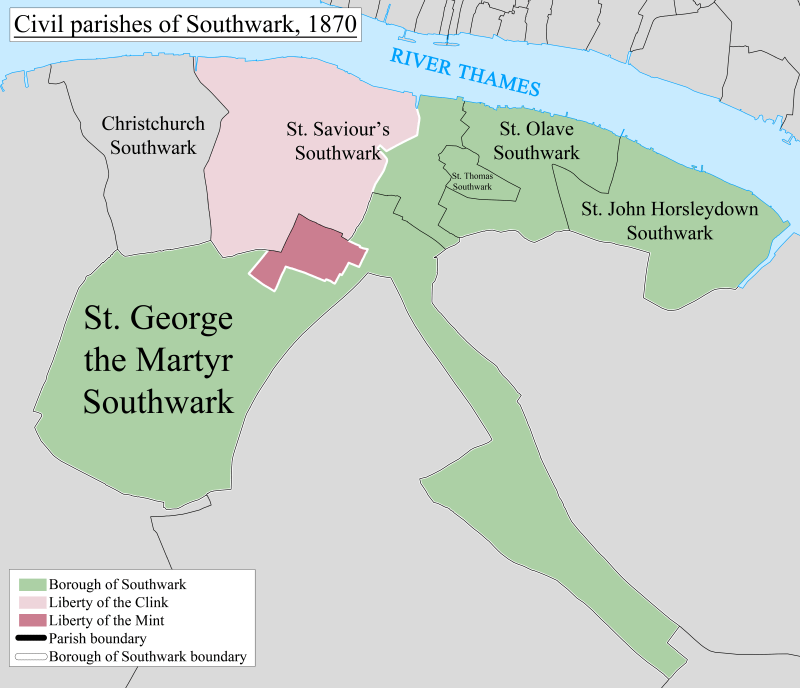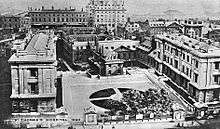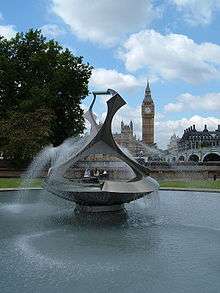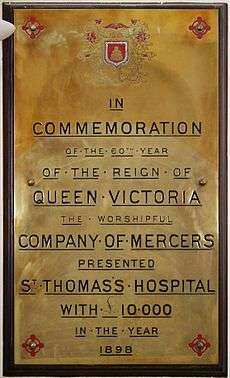St Thomas' Hospital
| St Thomas' Hospital | |
|---|---|
|
King's Health Partners Guy's and St Thomas' NHS Foundation Trust | |
|
St Thomas' Hospital, located across the River Thames from the Houses of Parliament | |
| Geography | |
| Location | Lambeth, London, England, UK |
| Organisation | |
| Care system | NHS |
| Hospital type | Teaching |
| Affiliated university | King's College London / KCLMS |
| Services | |
| Emergency department | Yes |
| Beds | 840[1] |
| Speciality | Dermatology, cardiothoracic surgery, obstetrics and gynaecology, children's services (Evelina London Children's Hospital), critical care, clinical pharmacology, cancer services, dentistry, urology, sexual health |
| History | |
| Founded | circa 1100 |
| Links | |
| Website |
www |
St Thomas' Hospital is a large NHS teaching hospital in Central London, England. It is one of the institutions that comprise the King's Health Partners, an academic health science centre. Administratively part of the Guy's and St Thomas' NHS Foundation Trust, together with Guy's Hospital and King's College Hospital it provides the location of the King's College London School of Medicine.
Originally located in Southwark, but based in Lambeth since 1871, the hospital has provided healthcare freely or under charitable auspices since the 12th century.[2][3][4][5] It is one of London's most famous hospitals, associated with names such as Astley Cooper, William Cheselden, Florence Nightingale, Linda Richards, Edmund Montgomery, Agnes Elizabeth Jones and Sir Harold Ridley. It is a prominent London landmark – largely due to its location on the opposite bank of the River Thames to the Houses of Parliament.
St Thomas' Hospital is accessible from Westminster tube station (a ten-minute walk across Westminster bridge), Waterloo station (tube and national rail, also a ten-minute walk) and Lambeth North tube station (another ten-minute walk).
History
The Hospital at The Borough, Southwark
The hospital was described as ancient in 1215[6] and was named after St Thomas Becket — which suggests it may have been founded after 1173 when Becket was canonised.[7] This date was when it was relocated from the precinct of St Mary Overie Priory to 'Trenet Lane', then later to St Thomas Street.[8] However, it is possible it was only renamed in 1173 and that it there was an infirmary at the Priory when it was founded at Southwark in 1106.[9][10]
.jpg)
Originally it was run by a mixed order of Augustinian monks and nuns, dedicated to St Thomas Becket, and provided shelter and treatment for the poor, sick, and homeless.[11] In the fifteenth century, Richard Whittington endowed a lying-in ward for unmarried mothers. The monastery was dissolved in 1539 during the Reformation and the hospital closed but reopened in 1551 and rededicated to Thomas the Apostle.[12][13] This was due to the efforts of the City of London who obtained the grant of the site and a charter from Edward VI and has remained open ever since.[14] The hospital was also the site of the first printed English Bible in 1537, commemorated by plaque on the remaining 1852 wing (now the Post Office on Borough High Street, opposite Borough Market.}
At the end of the 17th century, the hospital and church were largely rebuilt by Sir Robert Clayton, president of the hospital and a former Lord Mayor of London. Thomas Cartwright was the architect for the work.



In 1721 Sir Thomas Guy, a governor of St Thomas', founded Guy's Hospital as a place to treat 'incurables' discharged from St Thomas'.
The hospital left Southwark in 1862, when its ancient site was compulsorily purchased to make way for the construction of the Charing Cross Railway viaduct from London Bridge Station. The hospital was temporarily housed at Royal Surrey Gardens in Newington (Walworth) until new buildings on the present site in Lambeth near Lambeth Palace were completed in 1871.
Some parts of the old hospital survive on the north side of St Thomas Street, Southwark: from the old St. Thomas' Church (1704), now used mostly as offices but including the Old Operating Theatre, which is now a Museum, the neighbouring Treasury, and the row of Georgian houses on a corner near Joiner Street. The old hospital's 'Women's Ward', attached to the Operating Theatre, built in 1842 in dressed stone in a classical style, is best seen from Borough High Street. Its ground floor is now a main Post Office.
List of Priors, Masters, Wardens or Rectors
The following names are provided by the Victoria County History, Surrey:[15]
- Archdeacon Amicius, occurs 1213, 1215
- Adam de Merton, occurs 1235
- Thomas de Codeham, occurs 1248, 1251
- Fulcher, elected 1261
- Richard de Bikleswade, resigned 1283 " " (re-elected), died 1295
- Richard de Hulmo, 1295
- Walter de Marlowe. 1316
- Stephen de Bykleswade, occurs 1321, 1338
- William de Stanton, occurs 1338, 1342
- Walter de Marlowe, appointed 1350, 1351
- John de Bradewyn (Bradeway) appointed 1356
- Henry Yakesley, appointed 1361; died 1377
- William de Welfrid, appointed 1377; died 1381
- Thomas Gouday, appointed 1381; died 1392
- Henry Grygge, appointed 1393; occurs 1401
- John Reed, appointed 1414; died 1427
- Nicholas Bokeland, appointed 1427; resigned 1447
- William Crosse, appointed 1447; resigned 1478
- Sir William Twynyho (Master) 1485[16]
- William Beele, appointed 1478; resigned 1487
- John Burnham, appointed 1487; died 1501
- Richard Richardson, appointed 1501; resigned 1528
- Richard Mabbot, appointed 1528; died 1539
- Thomas Thurleby, appointed 1539; surrendered 1540
Medical training at St Thomas' Hospital
St Thomas's Hospital Medical School was established in 1550. Following the establishment of Guy's Hospital as a separate institution, this continued as a single medical school, commonly known as The Borough Hospitals, with teaching across St Thomas' and Guy's Hospitals. Following a dispute over the successor to the Surgeon Astley Cooper, Guy's established its own separate medical school in 1825 .[17]
The medical school subsequently remerged in 1982 with that at Guy's to form the United Medical and Dental Schools of Guy's and St Thomas' Hospitals (UMDS). Subsequent additions included the Royal Dental Hospital of London School of Dental Surgery joining with Guy's Dental School on 1 August 1983 and St John's Institute of Dermatology on 1 August 1985.[17] Following discussion held between 1990 and 1992 with King's College London and the King's College London Act 1997, the UMDS merged in 1998 with King's College School of Medicine and Dentistry to form as The Guy's, Kings & Thomas' Schools of Medicine (GKT School of Medicine), of Dentistry and of Biomedical Sciences.[17] This was renamed in 2005 as King's College London School of Medicine and Dentistry at Guy's, King's and St Thomas' Hospitals.
The Nightingale Training School and Home for Nurses opened at St Thomas' Hospital on 9 July 1860. It is now called the Florence Nightingale School of Nursing and Midwifery and is also part of King's College London.
The modern hospital

The present-day St Thomas' Hospital is located at a site historically known as Stangate in the London Borough of Lambeth. It is directly across the river Thames from the Palace of Westminster on a plot of land largely reclaimed from the river during construction of the Albert Embankment in the late 1860s.

The new buildings were designed by Henry Currey and the foundation stone was laid by Queen Victoria in 1868. This was one of the first new hospitals to adopt the "pavilion principle" – popularised by Florence Nightingale in her Notes on Nursing – by having six separate ward buildings at right angles to the river frontage set 125 feet apart and linked by low corridors. The intention was primarily to improve ventilation and to separate and segregate patients with infectious diseases. There was a seventh pavilion at the north end of the site next to Westminster Bridge Road for the "Treasurer's House" (hospital offices) and a nurses home. Between the middle ward pavilions was the entrance hall from Lambeth Palace Road and chapel. The medical school was at the southern end of the site. The formal layout to the Albert Embankment was also designed to complement the parliamentary buildings opposite.
The hospital was designed to accommodate 588 beds, although the hospital charity's fundraising was not sufficient to open all the wards until 1896.
As the Palace of Westminster is still technically a Royal Palace, a convention has been adopted that any commoner who dies within the Palace is officially recorded as having died at St Thomas' Hospital to remove the need to convene a jury of members of the Royal Household under the Coroner of the Queen's Household.
The northern part of the hospital site was severely damaged during World War II destroying three ward blocks. Limited reconstruction began in the 1950s including the building now known as East Wing. Complete rebuilding to a more ambitious plan to designs by Yorke Rosenberg Mardall, led then by Eugene Rosenberg, was agreed on in the 1960s requiring the realignment of Lambeth Palace Road further away from the river to enlarge the hospital campus. The new buildings have white-tiled cladding, which was a characteristic of several other university and hospital buildings designed by the YRM practice. As construction of the thirteen storey block (now North Wing) was completed by John Laing & Sons in 1975[18] there was a widespread public reaction against the scale and appearance of this building — most notably from MPs who could see it from the river terrace of the Palace of Westminster. The southern part of the redevelopment, which would have included a second tall block, was never constructed. The three remaining Victorian ward pavilion blocks were refurbished in the 1980s. They are now Grade II listed buildings.[19]

The current main pedestrian entrance is in Westminster Bridge Road, although there is a separate vehicle and A&E entrance in Lambeth Palace Road; there is also a riverside pedestrian entrance, and the Lane Fox Unit (chronic respiratory problems) has its own riverside entrance, mainly for the use of patients on the Lane Fox Ward. The pedestrian entrance to the campus leads to a glazed link between the Lambeth Wing and the North Wing. Guy's and St Thomas' Charity commissioned sculptor Rick Kirby to produce a sculpture "Cross the Divide", and this was unveiled in 2000 outside the Main Entrance. To the north of the North Wing (closer to Westminster Bridge Road) there is a garden area above car parking with Naum Gabo's fountain sculpture Revolving Torsion at its centre.

With the closure of the Dreadnought Seamen's Hospital at the Greenwich Hospital in 1986, services for seamen and their families are provided by the Dreadnought Unit at St Thomas' Hospital. It allows eligible Merchant seafarers access to priority medical treatment, except cardiac surgery, and is funded by central government with money separate from other NHS trust funds. It originally consisted of two 28-bed wards, but nowadays Dreadnought patients are treated according to clinical need and so are placed in the ward most suitable for their medical condition.
The St John's Institute of Dermatology department at the hospital has specialist skin pharmacy and specialist operating theatres.[20]
Following the merger of Guy's and St Thomas' Hospitals into one trust, accident and emergency services were consolidated at St Thomas' in 1990.
Former prime minister Harold Wilson died at the hospital on 24 May 1995, as a result of cancer and Alzheimer's disease.[21]
A unique unit was set up in the late 1990s by Dr Chris Aps, allowing cardiothoracic surgical patients to be rapidly recovered away from the Intensive Care Unit (ICU). This Overnight Intensive Recovery Unit (OIR) has become the template for similar units across the UK and remains active to this day.
Children's services are provided by Evelina London Children's Hospital. This moved from Guy's Hospital into a new building designed by Michael Hopkins on south eastern part of the St Thomas' site in 2005. The design of the new hospital, which is focused on a four storey conservatory has won several architectural awards for the way it has been designed to provide a friendly environment for children, many of whom are long term patients.
In 2010 an architectural design competition was launched by Guy's & St Thomas' Hospital NHS Foundation Trust and RIBA Competitions to re-imagine the cladding of the 1966 east wing building. Following this multi-stage process a shortlist of six practices were selected and Hopkins Architects with ISG were the final successful practice.
Evelina Children's Hospital was renamed Evelina London Children's Hospital in July 2013.
In order to minimise the costs of power and to minimise carbon emissions, St Thomas' Hospital utilises a combined heat and power plant that operates on natural gas.[22]
Tommy's
Tommy's is a UK-based charity that funds research into pregnancy problems and provides information to parents. They believe it is unacceptable that one in four women will lose a baby during pregnancy and birth. The charity started when two obstetricians working in the maternity unit at the hospital, were inspired to start fundraising for more research into pregnancy problems. Tommy's is a nickname of the hospital. They fund three research centres in the UK, including St Thomas' in London, St Mary's Hospital, Manchester, and the recently established Royal Infirmary of Edinburgh.[23]
The hospital as site of the first intraocular lens operation
On 29 November 1949, in an operating theatre of the hospital, Harold Ridley achieved the world's first implantation of an intraocular lens (IOL), treating a cataract in a 49-year-old female patient.
Ridley had completed his medical training in 1930 at St Thomas' Hospital. He subsequently worked as a surgeon at both Moorfields Eye Hospital and St Thomas', specialising in ophthalmology. He retired from the NHS in 1971. In the 1990s Ridley underwent successful bilateral intraocular lens implantation at St Thomas’s Hospital by the hospital's cataract surgeon Mr Michael Falcon. Harold Ridley benefitted from his own invention and the operational procedure he had pioneered. What was most pleasing to him was that he had the operations done in the same hospital where he had performed the first operation in 1949.[24]
In the New Year Honours 2000 list for the United Kingdom and New Zealand Harold Ridley was one of forty-five people accorded the honour of Knight Bachelor, "for pioneering services to cataracts surgery". At a ceremony in February 2000, he was knighted by HM Queen Elizabeth II at Buckingham Palace in London.[25]
Name
The use of the plural genitive s' in place of the singular genitive s's is fairly recent.
The hospital newsletter in 2004 claimed that plural s' is grammatically correct, as "there are two men called St Thomas linked to the hospital's history: Thomas Becket and Thomas the Apostle"[26] (A hospital belonging to two men, both called Thomas, would be Thomases', so the name change in the late 20th century is considered by some to be a simple mistake.)

Within the South Wing of the hospital there are a number of late Victorian brass plaques headed "St Thomas's Hospital" i.e. using singular genitive. However, the medical school used the singular genitive s's; the explanation given for this was that as the medical school of the hospital it was called "St Thomas's Hospital Medical School" (although following this logic it should perhaps have been called "St Thomas' Hospital's Medical School").[27]
Portrayal in fiction
- In the 1975 (UK release date) crime film Brannigan interior shots in an office set with a Thames river view constructed on an upper floor in the NE corner of the (built but not yet commissioned) North Wing stood in for "Scotland Yard" in scenes between John Wayne (Chicago police detective Brannigan) and Richard Attenborough (Metropolitan Police Commander Swann).
- Graham Swift's 1996 novel Last Orders features several scenes from the hospital where one of the main characters, Jack Dodds, dies from cancer.
- The main building was used as the exterior shot of the fictional Royal Hope Hospital featured in the Doctor Who episode "Smith and Jones". In the episode, the hospital is temporarily transported to the moon and a smoking pit is shown at the location of the real St Thomas' Hospital. In images of the hospital sitting on the moon, it appears that the main building of St Thomas' is used with an added tower. Most other exterior shots of the hospital appear to be of Singleton Hospital in Swansea, Wales, but modified using CGI to the resemble the more square shape of St Thomas'.[28]
- The hospital also featured in the 2002 film 28 Days Later in which the hospital was abandoned due to the nationwide outbreak of a deadly virus which causes its victims to go insane.
- Although it is not named in the novel, this is clearly the hospital in which Briony Tallis serves as a nurse during World War II in Ian McEwan's 2001 novel, Atonement.
- It was also used in an episode of Home and Away in 2014
- The clearance of the original site features in several episodes of the TV drama Strange Report. The episode 'Let Sleeping Heroes Lie', transmitted in 1969 (UK), features a body being discovered on the site by demolition workers.
See also
- Healthcare in London
- List of hospitals in England
- King's Health Partners
- Francis Crick Institute
- Florence Nightingale Museum
- Lambeth Palace Road, to the rear of the hospital
- Sarah Elizabeth Wardroper matron from 1854 to 1887
Footnotes
- ↑ "Guy's and St Thomas' NHS Foundation Trust: Our quality story". Retrieved 2014-05-16.
- ↑ http://www.london.ac.uk/history.html
- ↑ "The Foundation of St Thomas's" (PDF). p. 1.
- ↑ "A Chronology of State Medicine, Public Health, Welfare and Related Services in Britain 1066–1999" (PDF). p. 11.
- ↑ "Our history".
- ↑ "The Foundation of St Thomas's" (PDF). p. 1.
- ↑ "The Foundation of St Thomas's" (PDF). p. 1.
- ↑ "The Foundation of St Thomas's" (PDF). p. 1.
- ↑ "A Chronology of State Medicine, Public Health, Welfare and Related Services in Britain 1066–1999" (PDF). p. 11.
- ↑ "The Foundation of St Thomas's" (PDF). p. 1.
- ↑ "The Foundation of St Thomas's" (PDF). p. 1.
- ↑ "A Chronology of State Medicine, Public Health, Welfare and Related Services in Britain 1066–1999" (PDF). p. 11.
- ↑ "The Foundation of St Thomas's" (PDF). p. 1.
- ↑ "St Thomas's Hospital – A Concise History". gkt gazette. Guy's, King's & St. Thomas's Hospitals Medical & Dental Schools. February 2002 – continued in subsequent issues. Archived from the original on October 25, 2006. Check date values in:
|date=(help) - ↑ "Victoria County History, Surrey, vol.2, Hospital of St Thomas Southwark,". p. 119-124.
- ↑ As so described in the will of his father, the cloth-merchant John Twynyho(d.1485) of Cirencester
- 1 2 3 "St Thomas's Hospital Medical School Records". Archives in London and the M25 area (AIM25). External link in
|publisher=(help) - ↑ Ritchie, p. 147
- ↑ Good Stuff. "Block 9 of St Thomas's Hospital Medical School – Lambeth – Greater London – England – British Listed Buildings". britishlistedbuildings.co.uk. Retrieved 13 September 2015.
- ↑ "St John's Institute of Dermatology". Guy's and St Thomas' NHS Foundation Trust. April 2009. Retrieved 2012-05-04.
- ↑ "Harold Wilson". Info Britain.
- ↑ Guy's and St Thomas' Hospital CHP Plants, clarke-energy.com, accessed 14.03.2013
- ↑ "What does Tommy's do?". www.tommys.org. Retrieved 4 January 2013.
- ↑ Williams, H. P. (2001). "Sir Harold Ridley's vision". British Journal of Ophthalmology. 85 (9): 1022–1023. doi:10.1136/bjo.85.9.1022. PMC 1724118
 . PMID 11520745.
. PMID 11520745. - ↑ Apple, David J (2006). Sir Harold Ridley and his fight for sight. SLACK incorporated. ISBN 1-55642-786-7.
- ↑ "GSST People Magazine February 2004" (PDF). Archived from the original on September 26, 2007. Retrieved 12 February 2014.
- ↑ Crockford AL (December 1951). "History of St. Thomas's Hospital Medical School". Med Illus. 5 (12): 568–72. PMID 14910157.
- ↑ "Smith and Jones". Doctor Who. Season 3. Episode 1. 31 March 2007.
Bibliography
- Nightingale, Florence & Anon., Una and Her Paupers, Diggory Press ISBN 978-1-905363-22-3
- Victoria County History, Surrey, vol. 2, pp. 119–124, The Hospital of St Thomas, Southwark
- Ritchie, Berry (1997). The Good Builder: The John Laing Story. James & James.
External links
| Wikimedia Commons has media related to St Thomas' Hospital. |
- Guy's & St Thomas' Foundation Trust
- Old Operating Theatre Museum
- History of St. Thomas' annexe in Godalming Surrey
- Excerpts from Sir Harold Ridley's biography by David J Apple with some history of the modern hospital
- Dreadnought Unit information provided by the Seamen's Hospital Society's funded Seafarers' Benefits Advice Line
- The Dreadnought Seamen's hospital history by PortCities
- King's College London
- Survey of London entry (1951)
- {http://www.theroyalwaterlooexperiment.co.uk/ Website set up by patients of Dr William Sargant
- St Thomas patient reviews on Lasik-Eyes.co.uk
Coordinates: 51°29′57″N 0°07′08″W / 51.49910°N 0.11891°W

